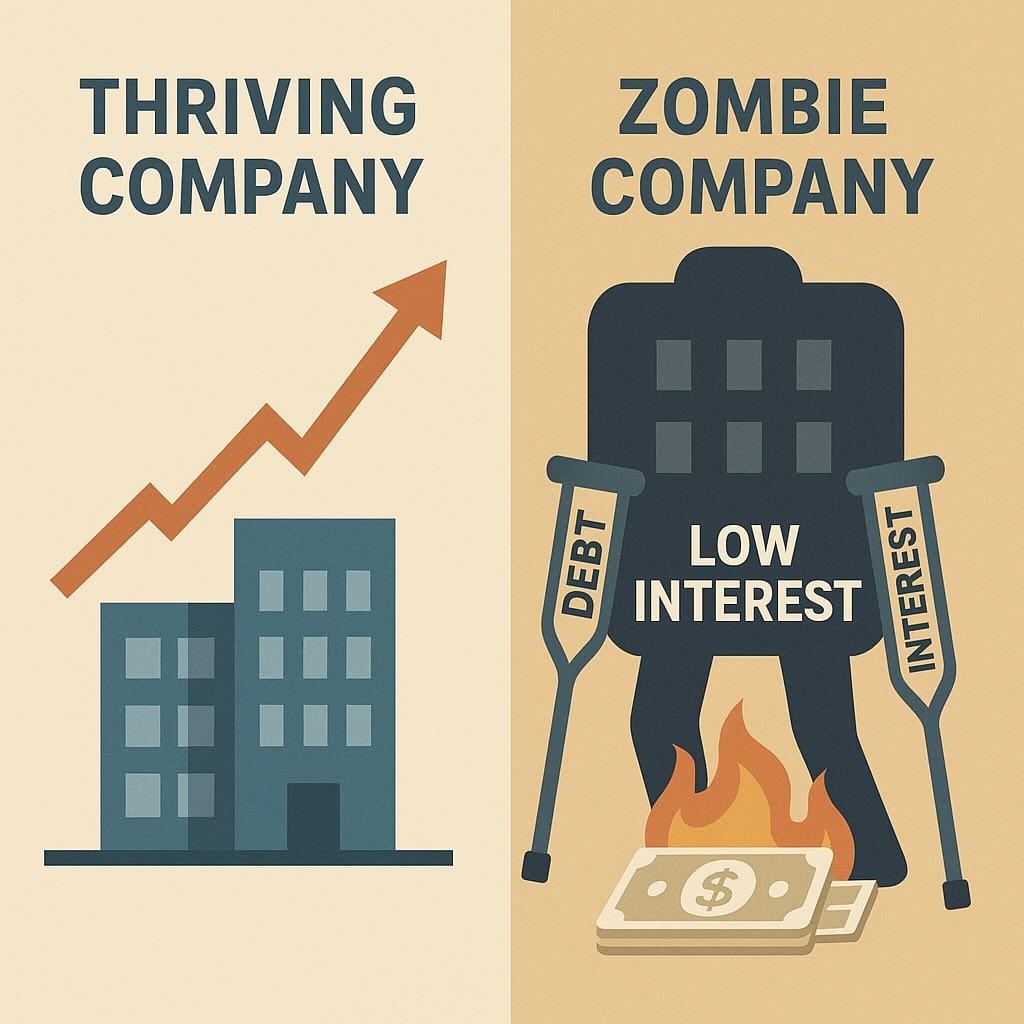A zombie company (or zombie firm, living‑dead firm) is one that cannot stand on its own feet.
It survives only because creditors roll over its loans at below‑market rates or because governments, directly or indirectly, prop it up. Most can just cover the interest on their debts; very few make enough cash to pay the principal, invest, or grow. If borrowing costs rise, or credit dries up, they are likely to fail.
Shares in such firms are often dubbed zombie stocks, while the expression zombie banks is applied to financial institutions kept alive by official support.

How the walking dead kept coming
Economist Edward Kane’s 1987 description of insolvent U.S. savings‑and‑loan associations first popularized the metaphor. Policymakers hoped the industry would “earn its way back,” but losses soon tripled, confirming Kane’s warning that the sector’s incentives were as perverse as those of movie zombies. The term resurfaced after the 2007‑08 global financial crisis, and again after the COVID‑19 shock, when emergency liquidity and ultra‑low rates allowed thousands of weak firms to muddle through rather than restructure or exit.
Tom Papworth, a Senior Fellow at the Adam Smith Institute, one of the world’s leading think tanks, listed the following features common in zombie companies:
- they are heavily indebted,
- they generate enough income to pay the interest on their debts, but cannot reduce the principle,
- their ability to meet loan interest payments depends on continuing low interest rates,
- and they are unable to restructure and become more profitable, because of the high costs in servicing their debts.
He notes that “the above [features of a zombie company] vitiates the need for the company to go into receivership, thus preventing the redeployment of capital and labor to more productive sectors.”
Why zombie companies matter
- Zombies hog labor, capital, and management talent that could flow into healthier, faster‑growing businesses.
- Their thin margins curb investment, innovation, and wage growth, dragging on productivity.
- When the population of zombies swells, recessions last longer and recoveries are weaker. The Bank for International Settlements estimates that when the share of zombie firms in an economy rises by 1% there’s a 0.3 percentage point drop in productivity growth.
Current scale of the problem
| Region | Latest estimate | Source & date |
|---|---|---|
| United Kingdom (mid‑market) | 15.9% of firms “at risk” in 2025 | BDO tracker (June 2025) |
| Canada | In 2019 specifically, it was 5.5% of firms | Statistics Canada study (2023) |
| Japan | ~1 in 6 companies (≈ 251,000) classified as zombies | Reuters (Mar 2024) |
Economists warn that the abrupt jump in policy rates since 2022 is exposing firms whose business models only worked when money was virtually free. Again, zombie firms by definition earn less than their interest payments. So, when rates rise, their already-negative coverage ratios worsen dramatically and they can no longer refinance cheaply or rely on new debt to stay afloat.
Telltale signs of a zombie company - 2025 edition
- Heavy leverage relative to cash flow.
- Interest‑coverage ratio < 1 for three consecutive years.
- Survival dependent on low rates or lender forbearance.
- Little or no R&D or capital expenditure, because servicing debt absorbs spare cash.
- No credible path to restructuring (management focuses on refinancing, not reforming the business).
These criteria, first framed by think‑tanks in the 2010s, remain valid; what has changed is that the margin for error has shrunk dramatically as financing costs have returned to pre‑2008 levels.
Recent case studies
| Company | Sector | What happened | Zombie angle |
|---|---|---|---|
| China Evergrande Group | Property | Ordered into liquidation by a Hong Kong court in Jan, 2024 after failing to present a viable restructuring for more than $300 bn in liabilities. | Propped up for years by rolling credit; liquidation shows limits of state tolerance. |
| ExpressJet | Aviation | CARES‑Act bailouts postponed, but did not prevent, bankruptcy; taxpayers absorbed losses while the airline kept unprofitable schedules. | Classic illustration of crisis support creating temporary “walking dead.” |
| Carvana (recovered zombie) | Used‑car retail | Cut over $1 bn of debt and swung to a $150 m profit in 2023; shares quintupled. | Shows that zombies can re‑enter the living if they deleverage and reform. |
| UK Mid‑Market Real Estate & Leisure Firms | Multiple | Rise in “at‑risk” share as floating‑rate debt resets. | Illustrates rate‑sensitivity of high‑debt, low‑margin sectors. |
Policy debate: treat or terminate?
- Central banks stress that letting zombies linger suppresses productivity and can even pull the natural rate of interest (r* ) lower, complicating monetary policy.
- OECD and BIS papers find that faster insolvency procedures, tougher loan‑loss recognition, and less tax bias toward debt all speed capital re‑allocation to healthier firms.
- Analysts urge lenders to distinguish between firms that can restructure (Carvana‑style) and those that merely refinance.
Key takeaway
Zombie companies are no longer an obscure post‑crisis footnote. They now form a sizable share of the corporate landscape in many advanced and emerging economies. With interest rates back near historical norms, the era of easy survival is ending. Firms that deleverage, cut costs, and overhaul their business models may yet escape the graveyard. Those that do not will finally be allowed to rest, in bankruptcy, freeing up capital and talent for enterprises that can thrive without life‑support.
